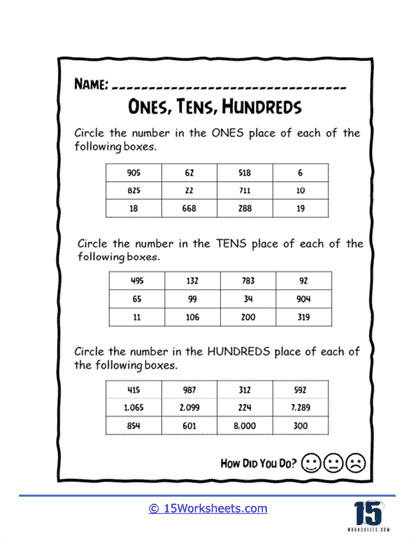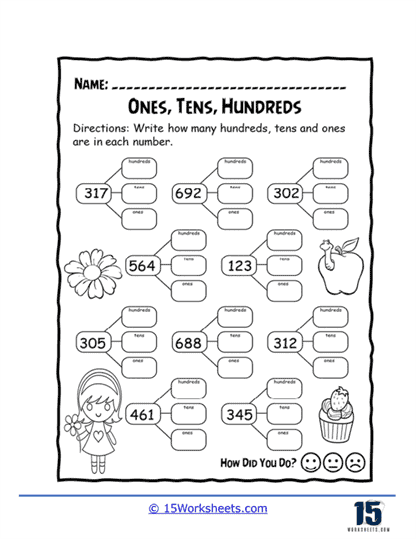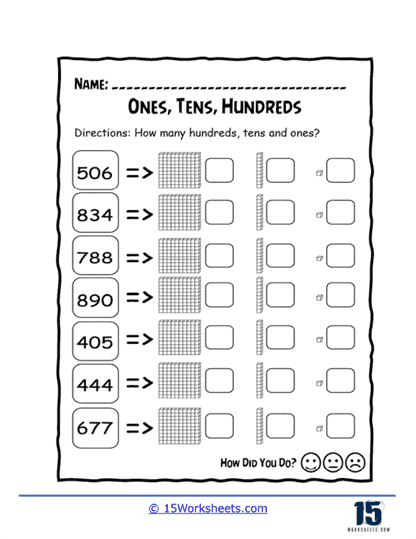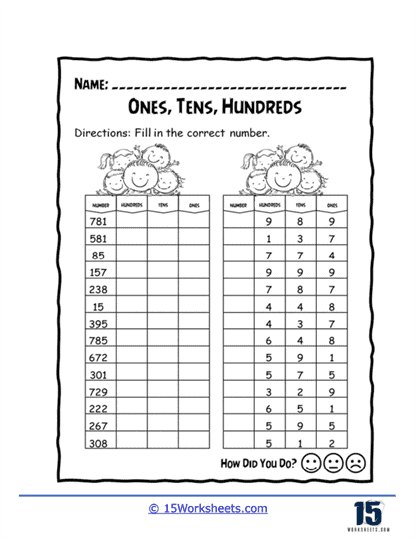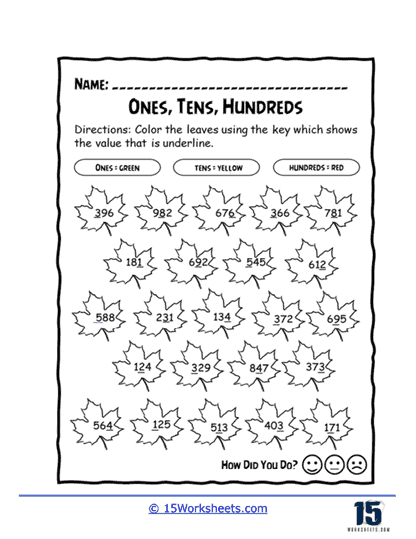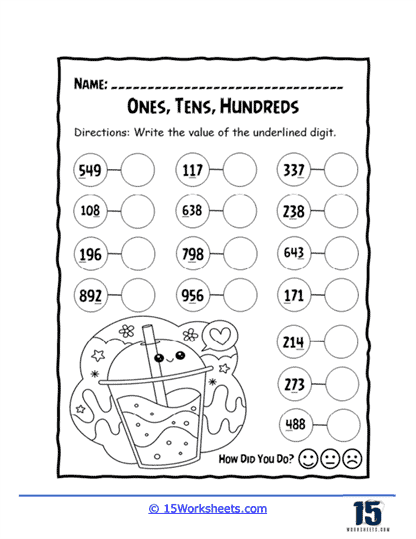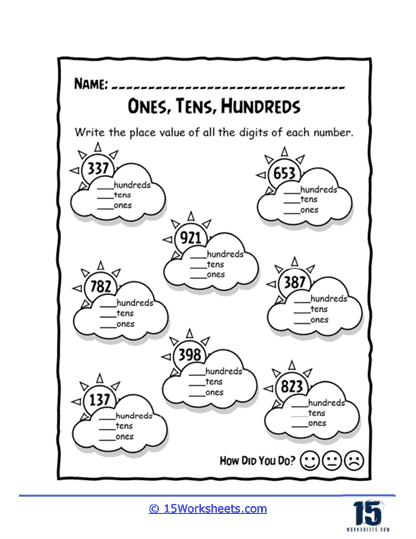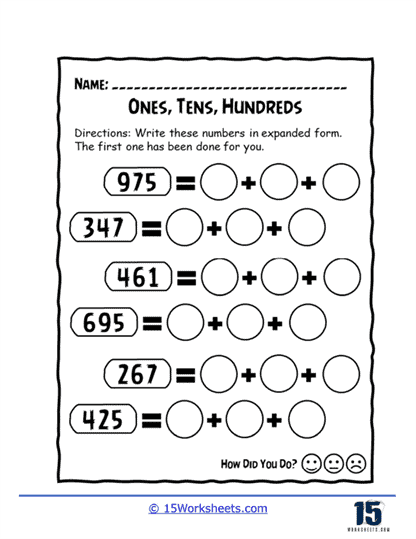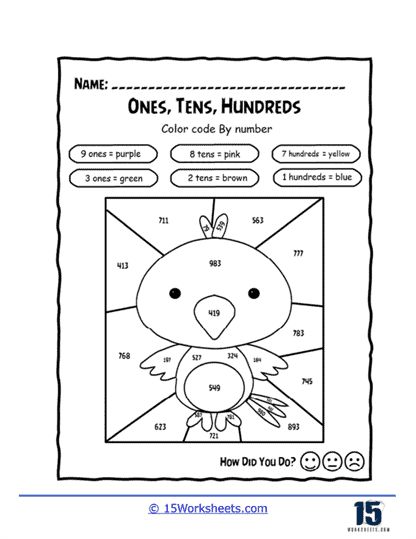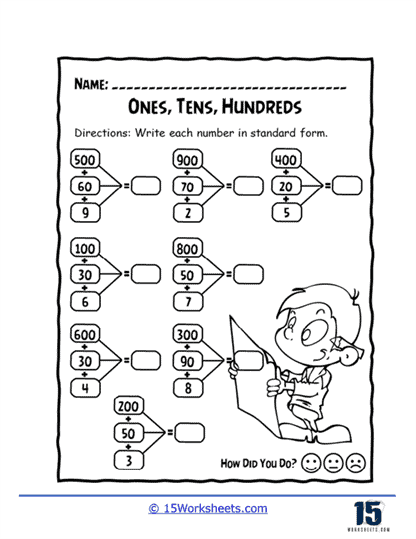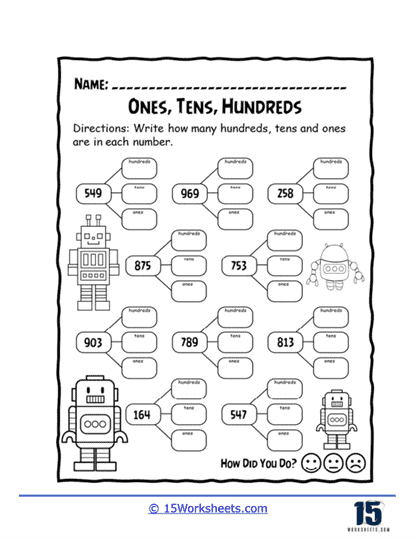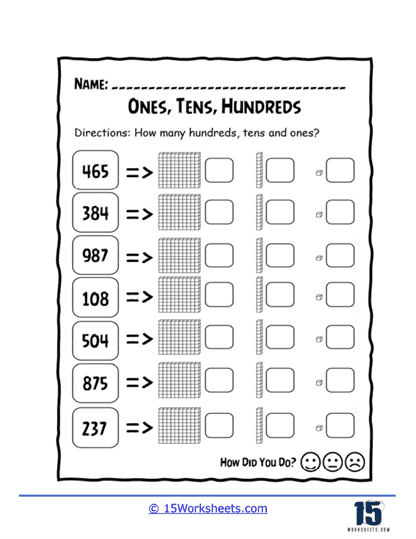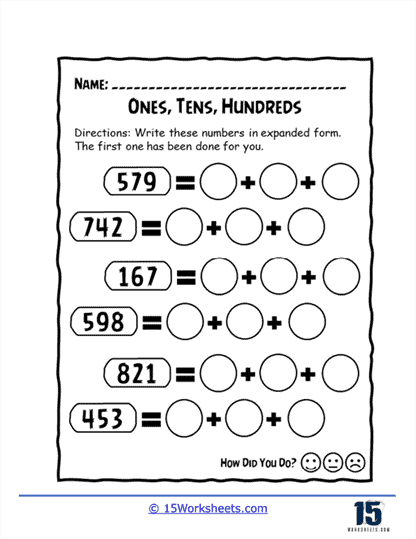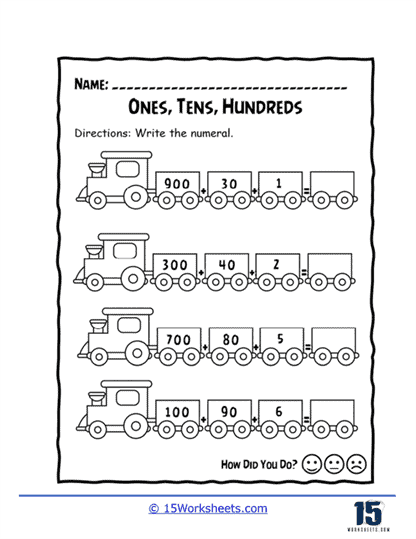Ones, Tens, Hundreds Worksheets
About These 15 Worksheets
Place value is one of the most foundational concepts in mathematics, shaping our entire understanding of numbers and how we work with them. At its core, place value refers to the value that a digit holds based on its position within a number. This seemingly simple concept is actually a powerful tool that underpins every arithmetic operation we perform, from basic addition and subtraction to more complex tasks like multiplication, division, and beyond. Without a strong grasp of place value, students may struggle to advance in mathematics, as it forms the framework upon which all numerical reasoning is built.
The worksheets provided are designed to help students not only recognize place value but also actively practice and strengthen their understanding of it through targeted exercises. These worksheets guide students through identifying, analyzing, and manipulating the digits in various place value positions-whether they are in the ones, tens, or hundreds place. Each exercise is an opportunity for students to engage with the base-ten system, a system that is the cornerstone of all arithmetic. The goal is for students to move beyond mere recognition and develop a deeper intuition for how numbers function within this system, giving them the confidence to approach more advanced mathematical problems.
Understanding place value is critical because it allows individuals to see how numbers are structured, giving them the tools to perform accurate calculations. For example, in the number 345, knowing that the digit ‘5’ represents five ones, the digit ‘4’ stands for four tens (or forty), and the digit ‘3’ signifies three hundreds (or three hundred) is much more than just memorizing rules. This knowledge transforms the number from a random collection of digits into a meaningful and logical entity, where each digit plays a role in determining the number’s total value. Mastery of this concept gives students the power to deconstruct and reconstruct numbers with ease, a skill they will use not only in math classes but in real-world situations requiring precise numerical understanding.
Place value is not just a concept learned in isolation-it’s integral to a variety of math topics such as regrouping in addition, borrowing in subtraction, understanding decimals, and recognizing the significance of large numbers. When students can confidently manipulate digits based on their place value, they are better equipped to tackle more challenging tasks, such as multiplying and dividing multi-digit numbers, converting units, or even solving algebraic equations. The ability to shift between the different places in a number allows for greater flexibility in problem-solving and fosters a more robust mathematical mindset.
By practicing with place value worksheets, students will build a solid foundation that prepares them for future mathematical success. This practice is not just about learning to get the right answers but about developing a strong sense of number sense. As students deepen their understanding of place value, they will find themselves better able to think critically and solve problems more efficiently, both in and outside the classroom.
What Each Place Value Represents
Here’s a breakdown of what each place value represents:
Ones – This is the rightmost position in a number. It represents the value of individual units or the count of items. For example, in the number 358, the digit “8” is in the ones place, representing 8 individual units.
Tens – The position to the left of the ones place represents tens. It signifies groups of ten. In the number 358, the digit “5” is in the tens place, representing 5 groups of ten, which is 50.
Hundreds – The position to the left of the tens place represents hundreds. It signifies groups of one hundred. In the number 358, the digit “3” is in the hundreds place, representing 3 groups of one hundred, which is 300.
What Types of Problems Do These Worksheets Have?
Identifying Places – Some questions might simply ask, “What number is in the tens place?” or “How many hundreds are in this number?” These questions are like detective work. You’ve got to find out where the number is hiding!
Adding and Subtracting – You might get questions that ask you to add or subtract numbers. The trick? Always start adding or subtracting from the rightmost side, the ones place, and move to the left. Remember, if you have more than 9 ones or tens, you need to “carry” them over to the next place.
Comparing Numbers – Some challenges might ask which number is bigger or smaller. Is 324 bigger than 235? You’ll start by looking at the hundreds, then the tens, and lastly, the ones to find out.
Filling in the Blanks – These are fun! You might get a number like 2__5 and then a question like, “What number should go in the tens place to make 285?” Time to put on your thinking cap and solve the puzzle!
Real World Skills
Improving your skills in identifying place values can greatly enhance your mathematical abilities. It forms the basis for addition and subtraction, especially when these operations require regrouping or borrowing. In multiplication and division, a strong grasp of place value assists in understanding how the numbers shift position as they increase or decrease in value. Moreover, place value knowledge is vital in understanding more advanced concepts like decimals and percentages, where the value of digits becomes even more nuanced. In essence, place value is a building block for numerical literacy and is indispensable for mathematical competence in both academic settings and everyday life.
Building a Strong Foundation – Just like when you build a tall tower with blocks, you need to start with a strong base. These basic math skills are the foundation for all the other fun math stuff you’ll learn in the future. And trust me, there’s a lot of cool math out there!
Shopping Smartly – Let’s say you’re buying candies, and one pack has 100 candies, another has 20, and another has 4. If you can understand ones, tens, and hundreds, you’ll quickly know you’re getting 124 candies! That’s a lot of sweetness.
Counting Money – When you start handling money, whether it’s saving up for a toy or counting your weekly allowance, understanding these places will help. If you have 3 one-dollar bills, 4 ten-dollar bills, and 2 hundred-dollar bills, you’ll quickly know how much money you have!
Time Management – When you look at the time, especially in minutes, understanding tens and ones can help you know how many minutes are left in an hour or how many have passed.
In the real world, understanding ones, tens, and hundreds can also help in baking (measuring ingredients), traveling (knowing distances), and even in sports (scoring points). It’s like having a math superpower!

